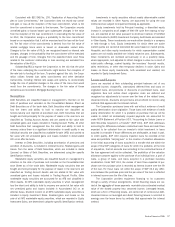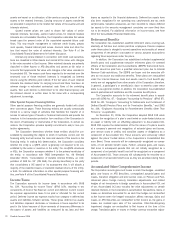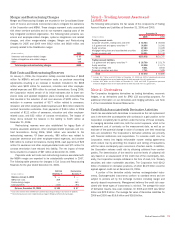Bank of America 2006 Annual Report Download - page 112
Download and view the complete annual report
Please find page 112 of the 2006 Bank of America annual report below. You can navigate through the pages in the report by either clicking on the pages listed below, or by using the keyword search tool below to find specific information within the annual report.assets are based on an allocation of the previous carrying amount of the
assets to the retained interests. Carrying amounts of assets transferred
are allocated in proportion to the relative fair values of the assets sold and
interests retained.
Quoted market prices are used to obtain fair values of senior
retained interests. Generally, quoted market prices for retained residual
interests are not available; therefore, the Corporation estimates fair values
based upon the present value of the associated expected future cash
flows. This may require management to estimate credit losses, prepay-
ment speeds, forward interest yield curves, discount rates and other fac-
tors that impact the value of retained interests. See Note 9 of the
Consolidated Financial Statements for further discussion.
Interest-only strips retained in connection with credit card securitiza-
tions are classified in Other Assets and carried at fair value, with changes
in fair value recorded in Card Income. Other retained interests are primarily
classified in Other Assets or AFS Securities and carried at fair value or
amounts that approximate fair value with changes in fair value recorded in
Accumulated OCI. The excess cash flows expected to be received over the
amortized cost of these retained interests is recognized as Interest
Income using the effective yield method. If the fair value of such retained
interests has declined below its carrying amount and there has been an
adverse change in estimated contractual cash flows of the underlying
assets, then such decline is determined to be other-than-temporary and
the retained interest is written down to fair value with a corresponding
adjustment to earnings.
Other Special Purpose Financing Entities
Other special purpose financing entities are generally funded with short-
term commercial paper. These financing entities are usually contractually
limited to a narrow range of activities that facilitate the transfer of or
access to various types of assets or financial instruments and provide the
investors in the transaction protection from creditors of the Corporation in
the event of bankruptcy or receivership of the Corporation. In certain sit-
uations, the Corporation provides liquidity commitments and/or loss pro-
tection agreements.
The Corporation determines whether these entities should be con-
solidated by evaluating the degree to which it maintains control over the
financing entity and will receive the risks and rewards of the assets in the
financing entity. In making this determination, the Corporation considers
whether the entity is a QSPE, which is generally not required to be con-
solidated by the seller or investors in the entity. For non-QSPE structures
or VIEs, the Corporation assesses whether it is the primary beneficiary of
the entity. In accordance with FASB Interpretation No. 46 (Revised
December 2003), “Consolidation of Variable Interest Entities, an inter-
pretation of ARB No. 51” (FIN 46R), the primary beneficiary is the party
that consolidates a VIE based on its assessment that it will absorb a
majority of the expected losses or expected residual returns of the entity,
or both. For additional information on other special purpose financing enti-
ties, see Note 9 of the Consolidated Financial Statements.
Income Taxes
The Corporation accounts for income taxes in accordance with SFAS
No. 109, “Accounting for Income Taxes” (SFAS 109), resulting in two
components of Income Tax Expense: current and deferred. Current income
tax expense approximates taxes to be paid or refunded for the current
period. Deferred income tax expense results from changes in deferred tax
assets and liabilities between periods. These gross deferred tax assets
and liabilities represent decreases or increases in taxes expected to be
paid in the future because of future reversals of temporary differences in
the bases of assets and liabilities as measured by tax laws and their
bases as reported in the financial statements. Deferred tax assets have
also been recognized for net operating loss carryforwards and tax credit
carryforwards. Valuation allowances are then recorded to reduce deferred
tax assets to the amounts management concludes are more likely than
not to be realized. For additional information on income taxes, see Note
18 of the Consolidated Financial Statements.
Retirement Benefits
The Corporation has established qualified retirement plans covering sub-
stantially all full-time and certain part-time employees. Pension expense
under these plans is charged to current operations and consists of several
components of net pension cost based on various actuarial assumptions
regarding future experience under the plans.
In addition, the Corporation has established unfunded supplemental
benefit plans and supplemental executive retirement plans for selected
officers of the Corporation and its subsidiaries (SERPS) that provide bene-
fits that cannot be paid from a qualified retirement plan due to Internal
Revenue Code restrictions. The SERPS are frozen and the executive offi-
cers do not accrue any additional benefits. These plans are nonqualified
under the Internal Revenue Code and assets used to fund benefit pay-
ments are not segregated from other assets of the Corporation; therefore,
in general, a participant’s or beneficiary’s claim to benefits under these
plans is as a general creditor. In addition, the Corporation has established
several postretirement healthcare and life insurance benefit plans.
The Corporation accounts for its retirement benefit plans in accord-
ance with SFAS No. 87, “Employers’ Accounting for Pensions” (SFAS 87),
SFAS No. 88, “Employers’ Accounting for Settlements and Curtailment of
Defined Benefit Pension Plans and for Termination Benefits,” and SFAS
No. 106, “Employers Accounting for Postretirement Benefits Other Than
Pensions,” as applicable.
On December 31, 2006, the Corporation adopted SFAS 158 which
requires the recognition of a plan’s over-funded or under-funded status as
an asset or liability with an offsetting adjustment to Accumulated OCI.
SFAS 158 requires the determination of the fair values of a plan’s assets
at a company’s year-end and recognition of actuarial gains and losses,
prior service costs or credits, and transition assets or obligations as a
component of Accumulated OCI. These amounts were previously netted
against the plans’ funded status in the Corporation’s Consolidated Bal-
ance Sheet. These amounts will be subsequently recognized as compo-
nents of net periodic benefit costs. Further, actuarial gains and losses
that arise in subsequent periods that are not initially recognized as a
component of net periodic benefit cost will be recognized as a component
of Accumulated OCI. Those amounts will subsequently be recorded as a
component of net periodic benefit cost as they are amortized during future
periods.
Accumulated Other Comprehensive Income
The Corporation records gains and losses on cash flow hedges, unrealized
gains and losses on AFS Securities, unrecognized actuarial gains and
losses, transition obligation and prior service costs on Pension and Post-
retirement plans, foreign currency translation adjustments, and related
hedges of net investments in foreign operations in Accumulated OCI, net
of tax. Accumulated OCI also includes fair value adjustments on certain
retained interests in the Corporation’s securitization transactions. Gains or
losses on derivatives accounted for as cash flow hedges are reclassified
to Net Income when the hedged transaction affects earnings. Gains and
losses on AFS Securities are reclassified to Net Income as the gains or
losses are realized upon sale of the securities. Other-than-temporary
impairment charges are reclassified to Net Income at the time of the
charge. Translation gains or losses on foreign currency translation adjust-
110
Bank of America 2006
























